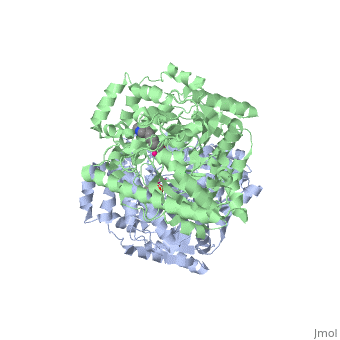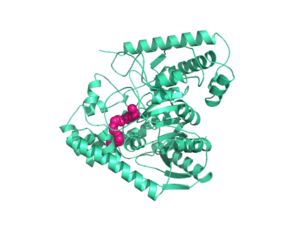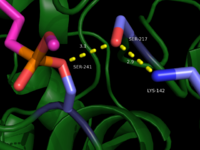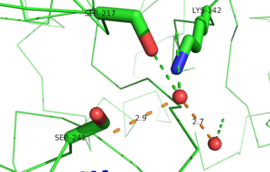Fatty acid amide hydrolase
From Proteopedia
(Difference between revisions)
| Line 5: | Line 5: | ||
}} | }} | ||
<StructureSection load='2VYA' size='350' side='right' caption='Fatty Acid Amide Hydrolase 1 (PDB: [[2vya]])' scene=''> | <StructureSection load='2VYA' size='350' side='right' caption='Fatty Acid Amide Hydrolase 1 (PDB: [[2vya]])' scene=''> | ||
| + | __TOC__ | ||
==Introduction== | ==Introduction== | ||
Fatty acid amide hydrolase (FAAH) degrades fatty acid amides (FAAs) to terminate their signaling activity <ref name="1MT5">PMID:12459591</ref>. A serine hydrolase from the [http://en.wikipedia.org/wiki/Amidase Amidase] signature superfamily of enzymes ([http://proteopedia.org/wiki/index.php/Category:Amidase other amidases]), FAAH degrades endocannabinoid signaling lipids, molecules associated with pain relief <ref name="2WAP">PMID:19389627</ref>. Because [http://en.wikipedia.org/wiki/Endocannabinoid_system endocannabinoids] are lipid molecules, they cannot be compartmentalized in vesicles (the degradation method for other neurotransmitters) and must instead be degraded in the bilayer of the cell membrane. FAAH is an [http://stevens.scripps.edu/images/faah_fig2.jpg integral membrane protein] that degrades FAAs as they enter the membrane bilayer, allowing the cell to terminate the activity of signaling molecules that cannot be contained within a vesicle for degredation <ref name="1MT5"/>. Current FAAH research aims to find inhibitors for the enzyme, which would prolong the pain alleviation provided by endocannabinoid molecules <ref name="2WAP"/>. | Fatty acid amide hydrolase (FAAH) degrades fatty acid amides (FAAs) to terminate their signaling activity <ref name="1MT5">PMID:12459591</ref>. A serine hydrolase from the [http://en.wikipedia.org/wiki/Amidase Amidase] signature superfamily of enzymes ([http://proteopedia.org/wiki/index.php/Category:Amidase other amidases]), FAAH degrades endocannabinoid signaling lipids, molecules associated with pain relief <ref name="2WAP">PMID:19389627</ref>. Because [http://en.wikipedia.org/wiki/Endocannabinoid_system endocannabinoids] are lipid molecules, they cannot be compartmentalized in vesicles (the degradation method for other neurotransmitters) and must instead be degraded in the bilayer of the cell membrane. FAAH is an [http://stevens.scripps.edu/images/faah_fig2.jpg integral membrane protein] that degrades FAAs as they enter the membrane bilayer, allowing the cell to terminate the activity of signaling molecules that cannot be contained within a vesicle for degredation <ref name="1MT5"/>. Current FAAH research aims to find inhibitors for the enzyme, which would prolong the pain alleviation provided by endocannabinoid molecules <ref name="2WAP"/>. | ||
| Line 45: | Line 46: | ||
[[6dhv]] – AtFAAH – ''Arabidopsis thaliana''<BR /> | [[6dhv]] – AtFAAH – ''Arabidopsis thaliana''<BR /> | ||
[[6dii]] –AtFAAH + methyl linolenyl fluorophosphonate<BR /> | [[6dii]] –AtFAAH + methyl linolenyl fluorophosphonate<BR /> | ||
| + | [[6kvr]] – FAAH – ''Candida albicans''<BR /> | ||
</StructureSection> | </StructureSection> | ||
Revision as of 11:15, 27 February 2023
This page, as it appeared on May 3, 2014, was featured in this article in the journal Biochemistry and Molecular Biology Education.
| |||||||||||
References
- ↑ 1.0 1.1 1.2 1.3 1.4 1.5 1.6 1.7 1.8 Bracey MH, Hanson MA, Masuda KR, Stevens RC, Cravatt BF. Structural adaptations in a membrane enzyme that terminates endocannabinoid signaling. Science. 2002 Nov 29;298(5599):1793-6. PMID:12459591 doi:10.1126/science.1076535
- ↑ 2.0 2.1 2.2 2.3 Ahn K, Johnson DS, Mileni M, Beidler D, Long JZ, McKinney MK, Weerapana E, Sadagopan N, Liimatta M, Smith SE, Lazerwith S, Stiff C, Kamtekar S, Bhattacharya K, Zhang Y, Swaney S, Van Becelaere K, Stevens RC, Cravatt BF. Discovery and characterization of a highly selective FAAH inhibitor that reduces inflammatory pain. Chem Biol. 2009 Apr 24;16(4):411-20. PMID:19389627 doi:10.1016/j.chembiol.2009.02.013
- ↑ 3.0 3.1 3.2 3.3 Mileni M, Johnson DS, Wang Z, Everdeen DS, Liimatta M, Pabst B, Bhattacharya K, Nugent RA, Kamtekar S, Cravatt BF, Ahn K, Stevens RC. Structure-guided inhibitor design for human FAAH by interspecies active site conversion. Proc Natl Acad Sci U S A. 2008 Sep 2;105(35):12820-4. Epub 2008 Aug 27. PMID:18753625
- ↑ Mileni M, Garfunkle J, DeMartino JK, Cravatt BF, Boger DL, Stevens RC. Binding and inactivation mechanism of a humanized fatty acid amide hydrolase by alpha-ketoheterocycle inhibitors revealed from cocrystal structures. J Am Chem Soc. 2009 Aug 5;131(30):10497-506. PMID:19722626 doi:10.1021/ja902694n
- ↑ 5.0 5.1 5.2 Mileni M, Kamtekar S, Wood DC, Benson TE, Cravatt BF, Stevens RC. Crystal structure of fatty acid amide hydrolase bound to the carbamate inhibitor URB597: discovery of a deacylating water molecule and insight into enzyme inactivation. J Mol Biol. 2010 Jul 23;400(4):743-54. Epub 2010 May 21. PMID:20493882 doi:10.1016/j.jmb.2010.05.034
Similar Proteopedia Pages
Student Contributors
- Rachel Erkilla
- Melissa Jones
- Daniel Lange
- Carter Sharp
Proteopedia Page Contributors and Editors (what is this?)
R. Jeremy Johnson, Michal Harel, Alexander Berchansky, Angel Herraez






